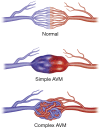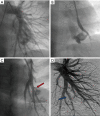Pulmonary arteriovenous malformations: endovascular therapy
- PMID: 30057880
- PMCID: PMC6039801
- DOI: 10.21037/cdt.2017.12.08
Pulmonary arteriovenous malformations: endovascular therapy
Abstract
Pulmonary arteriovenous malformations (PAVM) are abnormal direct communications between the branches of pulmonary arteries and veins, and are often seen in patients with hereditary hemorrhagic telangiectasia (HHT). If untreated, the right to left shunt can result in symptoms of hypoxemia, paradoxical emboli to the left side circulation, stroke and intracranial abscess. Endovascular therapy is a minimally invasive outpatient based treatment wherein the feeding artery to the PAVM is occluded with coils or plugs or a combination of both and is associated with minimal morbidity and no mortality. In this manuscript, we will review the indications and contraindications for endovascular therapy, pre-procedural work up, procedure technique and variations, complications, and outcomes.
Keywords: Pulmonary arteriovenous malformation (PAVM); coil; embolization; hereditary hemorrhagic telangiectasia (HHT); occlusion; plug.
Conflict of interest statement
Conflicts of Interest: The authors have no conflicts of interest to declare.
Figures















References
Publication types
LinkOut - more resources
Full Text Sources
Other Literature Sources
